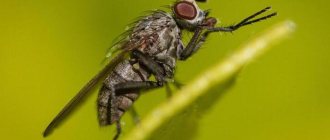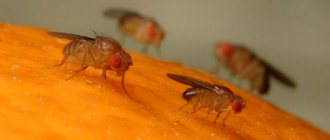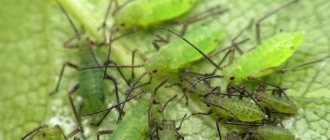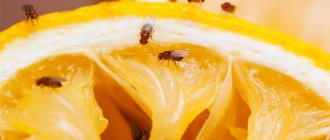Flies are annoying insects. They fly into houses and apartments through doors, balconies, open windows, ventilation holes, and garbage chutes. They will not leave the place if there are even the slightest unsanitary conditions (dirt, the smell of rotting food) or if there are outdoor toilets, compost heaps, landfills, or cattle pens near residential buildings.
Usually uninvited guests appear in the spring, when the temperature rises to +12 degrees. They wake up from hibernation and begin to look for food. The peak of the invasion is observed closer to autumn. Small pests flock to where it is warm. There they hide, hiding in the cracks. They hibernate (anabiosis), then begin to reproduce.
Small creatures cause psychological discomfort and are carriers of pathogens of dangerous diseases (tuberculosis, dysentery, jaundice, cholera, conjunctivitis, diarrhea). It is enough for them to sit on food once to inseminate with pathogenic microbes.
How to deal with flies at home, because it is better to deal with the problem at an early stage. Let's look at those methods that work 100%.
Why are flies dangerous?
- The main danger of flies is that they are carriers of various diseases. Other insects can also carry diseases, but the fly is especially dangerous because of its indiscriminate nature; these insects land on any surface, be it a flower or a pile of manure.
- Flies spread diseases such as diphtheria, tuberculosis, polio, typhus, jaundice, cholera, and helminthiasis. That is why foods that a fly has landed on should never be eaten.
- These winged creatures multiply at an amazing speed. In just a week, a couple of flies in your yard can turn into a whole swarm.
There are a number of ways to help get rid of flies in the yard of a private home.
How to fight flies in wooden houses using folk methods?
If the use of chemical products is unacceptable for you, and flies are extremely annoying, then try to drive them out using traditional methods. For example, black pepper is a nightmare for flies; for them it is a real poison. Place three pinches of ground black pepper in a glass of sweet water and leave in the room. After an hour, all you have to do is collect the dead insects from the bottom of the glass.
Flies in a wooden house in the fall are frequent guests. You can prepare a trap for them with your own hands. Just take a newspaper and soak it in sweet water. When the paper dries, it will become an extremely effective trap for annoying insects.
Keep the yard clean
It is well known that flies are attracted to strong odors, and it does not matter whether it is the smell of blooming roses, fried meat or a garbage can. Therefore, first of all, in order to get rid of flies in the yard, you need to restore complete order. Pay special attention to dog feces, their smell especially attracts flies. Place your pet's waste in tightly sealed bags and place it in the trash.
The trash can on the site must have a lid. Always close it tightly; if you have guests over, ask them to do the same.
Breeding sites
Due to the enormous rate of reproduction of flies, you must first take care of their breeding sites. Flies lay eggs in damp places, so breeding sites can be:
- ditches;
- open waters;
- the ground under boards, driftwood, walkways;
- toilet;
- septic tanks, water tanks and the ground underneath them;
- garbage heaps and containers.
The developmental cycle of a fly from larva to adult:
All these areas should be dried or disinfected. After this, as a preventive measure, you need to follow several rules:
- promptly drain all unnecessary reservoirs on the territory, do not allow tanks with standing water to exist at your dacha that you do not use;
- regularly remove boards, construction and garden waste from the territory, and mow the grass;
- Keep the area clean, throw away all trash, and let your pets walk outside the garden.
Cleanliness and dryness are a guarantee of the absence of flies in the country house.
Dry toilets for summer cottages
Dry toilets are a lifesaver in the absence of cesspools and wooden cabins. The innovation was created in order to reduce the number of flies in the country, but for this you need to follow the operating instructions. A dry closet can be placed in any room or extension, but it is better not to place it outside.
Dry toilets use peat or biologically active liquids as raw materials. They do not require much space and are quite easy to carry. In addition, they do not contain drainage liquid, the contents are dry, which simplifies the disposal of waste products. Waste is decomposed by bacteria contained in bioactive liquid or peat.
Components of a dry closet:
The dry closet does not produce any odor; on the contrary, it absorbs all odors from the air. For additional guarantee, many dry closets have an exhaust pipe exposed through the window. The design is quite cheap, slightly more expensive than arranging a classic wooden toilet.
Is it possible to get rid of flies without changing the situation in the toilet?
If you leave comfortable conditions for reproduction, the flies will periodically return. But it is possible to significantly reduce their population without eliminating sources of infection and food for flies. But such a struggle will last indefinitely with rather dubious results.
Monitor the condition of your lawn
Flies often take a break from the midday heat in the tall grass. Mow your lawn regularly. Thus, you will not only make your garden plot more attractive, but also deprive annoying insects of shelter. The cut grass should be immediately put into the trash can, and the container should be tightly closed with a lid. Freshly cut grass has a very strong smell, which also attracts flies.
What is the danger of flies
It may seem that flies are harmless creatures that only bother you with their annoying presence and fly aimlessly. But in fact, such insects can carry various parasitic and infectious diseases on their paws and wings:
- the occurrence of worms in the body;
- cholera;
- jaundice;
- typhus;
- polio;
- tuberculosis;
- diphtheria;
- and others.
Some varieties of these insects can infect humans with eye diseases (trachoma, conjunctivitis). You can accidentally eat the eggs that flies lay as food, and as a result, develop miasma in the intestines. If a fly is found on food cleaning its legs, then such food should no longer be eaten.
Main symptoms:
- various intestinal disorders;
- body temperature often increases;
- skin itching;
- increased liver volume;
- drop in blood pressure.
- and other.
If you do not treat diseases, your health can significantly deteriorate, even leading to death.
Remember the compost
Decaying plants attract flies just as much as trash cans. If you collect compost on your site, make sure that it is not too wet (moist, warm environments are loved by flies), make a compote pile or pit as far as possible from the entrance to the house, and make sure that the rotting processes do not stop ( at the high temperature that accompanies the rotting process, fly eggs do not survive, so insects do not fly over such compost).
Make fly traps
If you can’t drive away the flies, you can, on the contrary, lure them to a place located further from the house. We offer you several proven ways to get rid of flies in your yard.
- Mix rosin and castor oil in equal proportions. The resulting liquid should be heated on the stove and a couple of tablespoons of honey or jam should be added. The resulting syrup should be greased with pieces of cardboard and placed on the site.
- You can treat paper in a similar way using syrup made from water, sugar and lemon juice.
- After gatherings with friends, you can leave a bottle of beer in an open place. Flies love the smell of alcohol, they will flock to it, crawl into the narrow neck of the bottle, and will not be able to get out.
- Based on the same principle, they make a fly trap from a jar and a sheet of paper. Any sweet liquid is poured into a jar, a cone is made from paper and placed in the jar with the sharp end up. Flies, attracted by the smell, will climb into the jar, but they will not be able to get out through the narrow hole.
- Pour some vinegar and dish soap into a jar. Cover the jar with cling film. Make a hole in the center so that a fly can get through. Flies will also not be able to fly out of this trap.
- Mix peanut butter, honey and craft glue. The sweet smell will attract flies, and the glue will prevent them from coming off the surface. You need to grease the pieces of paper with the paste and spread them around the yard.
Flies in the house - preventive measures
The best solution to the problem is to ensure that flies do not enter the house at all. Of course, in a country house or house in the summer, windows and even doors are often open, but flies are not a reason to sit in a stuffy room. You need to put a mesh on the windows (at the dacha you can use old tulle and attach it with ordinary push pins), it is better to make a special frame on the door, on which the mesh will also be installed. It is important that all household members get used to closing this frame behind them every time. It is especially difficult with children who run in and out of the house countless times. Take this into account and, just in case, hang adhesive tape; it will cope with a few flying flies.
Do not leave food exposed, and always keep the trash can closed with a tight lid.
A good time-tested method is to wipe tables, all furniture, window frames and doors with laurel oil a couple of times a month. The smell is neutral for humans, but flies avoid it. Insects will try to leave such a room faster and will subsequently fly around it.
An invariable attribute of garden and personal plots are cesspools and compost heaps. They are the ones that attract flies from all over the area. If the accumulation of waste can be avoided by promptly sending the garbage to a landfill, and there is no escape from the cesspool, then in this case, treatment against flies with a water emulsion of karbofos or a mixture of soap and kerosene will help. Spraying should be done once a month, not more often.
If your country house is located next to a cowshed or an area where livestock often grazes, then the appearance of winged individuals on the site in large numbers is simply inevitable. In this case, it is necessary to use a special hardware trap or insecticidal lamps. However, taking into account the fact that for a large area you may need not one, but several, and the cost of one device is quite high, it is reasonable to try less expensive options first. Let's consider which ones.
For example, it may not only be adhesive tapes suspended from the ceiling, as mentioned above. These are special granular powders and compositions, such as the Flight fly trap and similar analogues, homemade traps made from plastic bottles with attracting substances and many other devices, means and baits that will allow you to install them on your property or at home in places of greatest concentration in the required quantity (at the rate of 1-3 traps per 10 sq.m.). Being placed on substrates or in special containers at the closest distance from each other, the traps will not only attract flies from all over the area, but also successfully destroy them.
A fairly effective, but at the same time harmful to the environment and relatively expensive option is to treat the area with a chemical every month. If you live in a country house, it makes sense to walk around your summer cottage within a radius of about two hundred meters and check if there are any garbage dumps or any accumulation of waste nearby. Perhaps the problem with garbage as a source of breeding for flies is temporary. For example, abandoned property full of waste.
Or it may well be that the problem is systematic, protracted - say, neighbors who do not want to clean up their garbage after themselves. And if the source with flies is properly removed, the space underneath is thoroughly cleared, and the area is put in order, then after the first treatment the flies will leave the territory of the country house forever (at least in such large numbers you will no longer see them. And with proper practical measures inside the house, flies will no longer fly under the roof of the house.
Buy electric traps
Have you ever wondered what repels flies in the courtyard of outdoor cafes? Owners of cafes and restaurants most often use electric insect traps. So why not use this fly repellent in the yard of a private home?
The principle of the trap is that flies and other insects fly towards the light emitted by the trap. As soon as they land on the metal grid, they are electrocuted.
Such traps can be hung in the yard at night. Traps should be hung away from the dinner table; no one wants to see a dead fly in their soup. Also be careful with such devices if you have small children or pets in your home. An electric trap will not cause serious harm to a person or large animal, but it may cause pain.
Note!
DIY metal bench: instructions with step-by-step guide (100 photo ideas)
Blinds for gazebos: wooden, metal, bamboo. Instructions for installing blinds yourself
Adding a terrace to your house with your own hands: step-by-step instructions on how to easily and quickly add a veranda or terrace (100 design photos)
Dangerous "neighbors"
Flies, paradoxically, have become a common occurrence in human life. They begin to get rid of flies only when their number begins to irritate. Small, light synanthropes reach 6-8 mm in length. They have a gray body color, covered with sparse long hairs, and large compound eyes. The oral apparatus of flies has a licking-sucking structure. They eat only liquid food; solid particles have to be dissolved in saliva.
The lifespan of dipterans depends on the ambient temperature and can vary from 2 weeks to a month. Every year there are 9 to 20 generations of house flies. In cold rooms they are inactive and awaken at ambient temperatures above 10°C.
Interesting!
Females are highly fertile and require protein foods to mature their eggs. During their life they are capable of making more than 6 clutches. Depending on climatic conditions, an adult fly can lay up to 2000 eggs.
In people's homes, they are attracted to food scraps, unopened foods that are easily accessible to flies. Favorable habitats for synanthropes are places with large accumulations of garbage, dirt, and rotting organic waste of various origins. On their paws, flies carry a huge number of microbes, which they leave on food. Eating them without pre-treatment can lead to the development of the following serious diseases:
- diarrhea;
- dysentery;
- typhoid fever;
- tuberculosis;
- cholera;
- helminthiasis and other infections.
Important!
The complete transformation cycle (egg→larva→pupa→imago) lasts for 25-30 days. If measures are not taken in a timely manner, you will have to face big troubles, because you can become infected not only in the spring and summer. Flies in the fall can cause a lot of trouble. Their close relative, the autumn zhigalka, which feeds on blood, prefers to settle in a barn, on a pasture. Closer to autumn, it appears in the residential houses of summer residents. Its bites are quite painful and can lead to dangerous infections.
Plant carnivorous plants
There are several species of carnivorous plants that are adapted to life in our latitudes. Predatory plants lure insects, including flies, with a sweet smell, and when they land on a flower, they slam the trap and digest them.
In flower shops you can find sarracenia, Venus flytrap and nepenthes. Plant several of these plants in your area, they will definitely reduce the number of flies in your yard.
Types of flies
The most familiar to us and often found in our area is the housefly, it comes from Asia. Its body is dark gray with a brown tint and black longitudinal stripes.
We also see the green fly (“meat fly”). She has a large body of emerald color. This is a very annoying species of insects that are attracted to meat waste and sewage.
In nature you can find hover flies; their small bodies are similar in color to that of a wasp. They are quite harmless, do not bite and make gurgling sounds.
Flies that besiege plants are flower flies. Depending on the “favorite” objects, they are called differently: toffee, cherry, onion, beet, etc.
Flower flies look like regular flies, but their bodies are more graceful. The body of the flower fly is dark gray with yellowish spots. They pierce a young flower bud and lay eggs in it.
The larvae, hatching from the egg, eat the flower. As a result of this, it rots. The larvae themselves fall to the ground and, turning into pupae, overwinter in the soil. The next year, the pupa turns into a fly and this cycle begins again.
Spread the spices on the area
The tastes of people and flies are very different. If we are disgusted by the stench of garbage, then flies fly away from the smell of some spices that are aromatic for us, such as cloves. Clove flowers contain so many phytoncides that even dried spice can repel flies. Lemon can enhance the effect of cloves. From these two products you can make several homemade fumigators, which need to be placed at different ends of the yard.
The lemon needs to be cut in half. Stick 5-6 cloves into each half. The repeller will work for 3-4 days until the lemon begins to deteriorate.
Note!
How to attach a veranda to your house with your own hands - step-by-step instructions from A to Z + photos of new designs
Do-it-yourself columnar foundation for a gazebo: detailed instructions from A to Z + photo
DIY economy class garden gazebo - instructions on how to build quickly and cheaply. Photos, diagrams, drawings, layout and design
Fighting flies
Chemical preparations available on the market show good results in killing fruit flies, house flies and carrion (green) flies. Many people are wary of using chemicals indoors, especially in the kitchen. For them, there are methods proven over centuries to get rid of flies using folk remedies:
- homemade sticky traps;
- solutions;
- saccharin;
- black pepper;
- vinegar;
- kerosene;
- repellent plants;
- homemade insecticides.
Sticky tapes are an old and tried-and-true fly trap. The animal's paws stick tightly to the adhesive tape. It has gained popularity due to its comparative cheapness and good results. This method is not suitable for everyone, because the sight of a long ribbon covered in large green flies scares many people away.
The most pleasant way to forget about flies in your rooms is to plant flowering plants under the windows in the yard that repel not only flies, but also many other insects. And the eye is happy, and flies do not fly into the room.
Plant fly repellent plants in your yard
An excellent remedy for flies in the yard are live plants that emit a specific smell. They will repel flies with their smell. Such plants include:
- Elder;
- Lavender;
- False indigo;
- Basil;
- Mint;
- Bird cherry;
- Tansy;
- Amorphous.
These plants can be planted directly in the ground or planted in pots and placed near a seating area on the lawn.
Mechanical methods
A traditional old fly swatter does the job perfectly if there are only a few flies in your dacha. The process of killing flies may take several hours, and besides, you will not kill all the flies at once. But the method is completely free and extremely simple, so you should definitely use it.
Chemistry
It must be remembered that many drugs are dangerous to humans and they must be used with a protective mask, and after use, leave the room until it is ventilated. None of the products destroys insects 100%, so you need to use several control methods at once and repeat the planned destruction several times.
- Aerosols. The most famous insect repellents. It is better to purchase specific aerosols aimed specifically against flies. This way you will not destroy beneficial insects in your dacha. In addition, such means are usually more harmless to humans. To kill flies, you need to spray the product indoors and in secluded corners in the garden.
Any insecticide in an aerosol is poison, so carefully follow the instructions and safety precautions.
- Biological products. These powdered products contain live bacteria that destroy organic compounds. Cesspools, ditches and other similar places are cleaned with such preparations. The products are relatively harmless and, if the instructions are followed, do not pose a danger to animals and plants.
- Chlorine. Cesspools are also cleaned with this product, but unlike biological preparations, chlorine is toxic to all animals and plants. Its only advantage is its lower price. This drug can completely poison the soil, as a result the plants may die and the water in the well will become poisonous. Not recommended for use.
Plants that do not tolerate flies:
- Fumigators. These are plates that, when heated or ignited, emit a gas that is poisonous to flies, but harmless to humans. Vaportrin is usually used in fumigators; they do not act immediately, but after 20-30 minutes. The product gives maximum results after 2-3 hours. Fumigators operate on mains power, so they cannot be used in all rooms. High-quality plates for them are expensive, but they give a guaranteed result.
Folk remedies
There are many folk recipes. Some use plants and their scents, others repel but do not kill flies, and others are homemade traps.
- The simplest, but not the cheapest way is to spray alcohol or vodka using a spray bottle. Flies cannot tolerate alcohol vapors in the air and will quickly clean the room. In addition to the relatively high price, the method has two more disadvantages - spraying alcohol will only repel flies and the repellent effect will go away as soon as the room is ventilated.
- The method is similar to the previous one, only it is not alcohol that is poured into the spray bottle, but diluted essential oil of clove, mint or lavender. Essential oil should be diluted in water in the amount of 5 ml of oil per 500 ml of water. You need to use it carefully, as allergic reactions may occur.
Crops that repel various insect pests:
- Live traps - sundew plants, Venus flytrap and others. These flowers are living predators. Plants usually extract nutrients from the soil, but these flowers get them by hunting insects. The fly becomes trapped in the plant, where it is digested using a solution similar to gastric juice. But we must remember that some plants emit unpleasant odors to attract insects.
- To repel insects, you can grow flowers and plants in your dacha that flies do not like. Such plants include geranium, basil, lavender, bay leaf and others. Most of them can be grown both in pots and in a flower bed. You can also make repellent tinctures from these plants or use dry leaves.
Please note that some products repel insects, while others lure and kill them in a trap. These are opposite methods of action, so they cannot be used together.
Store-bought fly repellents
When thinking about how to kill flies in your yard, use commercial fly repellents along with fly-repellent plants. Together they will certainly allow you to get rid of annoying winged creatures. In the courtyard of the house you can use:
- Sticky bait tapes;
- Insecticide lamps;
- Fumigators;
- Ultrasonic insect repellers;
- Insect repellent solutions safe for humans. Some of them are sprayed into the air, others are applied to the walls of the house.
Mechanical means of control
Protection against flies involves the use of various types of Velcro, baits, electrosonic repellers, and fly swatters. They are safe for people and pets and are suitable for getting rid of a small number of flies that have flown into an apartment or house. The most common means are:
- Duct tape. It is quite effective. The principle of operation is based on the impregnation of paper strips with a special sticky smelling substance that attracts pests. In the house, ribbons are hung in the room, on the balcony, kitchen, loggia, and near lighting fixtures. Flying towards the smell, the fly gets stuck and can no longer free itself.
- Traps. They come in two types. The light trap operates similar to sticky tape. Insects are only attracted to the bright light they fly towards. There is a sticky mixture inside the flashlight or glowing screen. Once stuck in it, the fly is unable to get out. You can make a trap with bait yourself using a plastic bottle. Using a knife or scissors, cut it into two parts - a smaller one with a lid and a larger one with a base. Sugar and chopped banana are poured into the bottom, jam and honey are added, and water is added. After this, the smaller part of the bottle is inserted into a larger container, neck down. Once a fly gets inside, it will not be able to get out.
Fly swabs
Folk remedies
If you don’t know how to kill flies in your yard, but don’t want to use store-bought chemicals, use folk recipes. Folk remedies for flies can be based both on the use of natural remedies and on the basis of chemicals.
- Poison based on chlorophos. To make your own poison for flies, add 1 teaspoon of sugar and a quarter teaspoon of chlorophos to 100 grams of water. The resulting solution should be poured into small containers and placed in places inaccessible to children and pets.
- Flies are repelled by the smells of turpentine, vinegar or castor oil. Washing all surfaces in your yard with water mixed with one of these substances will help keep flies from coming into your yard.
- As much as flies love natural sugar, the sweet substitute saccharin is so destructive for them. Add 20 grams of natural honey and 2 grams of saccharin to a glass of water. Moisten the paper with the resulting solution and place it out of the reach of children. Flies that taste this poison will soon die.
- Fly poison can be obtained by mixing milk, sugar and formaldehyde.
- One of the most effective poisons for flies is a mixture of one teaspoon of ground black pepper with two teaspoons of sugar.
Note!
Do-it-yourself garden path using a mold: a review of original and inexpensive ideas + step-by-step instructions with photos
Do-it-yourself gazebos for a summer residence - 300 photos of exclusive ideas. Instructions for building a beautiful gazebo (diagrams, drawings, foundation, roof)
How to insulate a veranda for winter living: floor, ceiling, walls. Examples of insulation from the inside and outside (instructions + photos)
DIY fly trap: diagram
One of the most popular methods is the use of traps. You can make them yourself from available materials.
DIY fly trap:
- To do this, you need to take a plastic bottle, cut off the neck from it at a distance of 10 cm. Next, pour water and sugar into the second part of the bottle.
- In this case, the part with the neck is lowered into the lower bowl, so that it does not come into contact with the liquid. After a few minutes, the flies will want to feast on the sweet water, they will climb into the trap, but will not be able to get back out.
- Be prepared for a large number of insects floating on the surface of the sweet water.
Homemade duct tape. It is necessary to mix rosin, castor oil and honey in equal quantities. Now you need to hand over thin cotton ribbons. You can tear them from an old sheet. Soak the strips in the resulting solution. The principle of operation is the same as that of adhesive tapes. The fly sticks, but cannot fly back.
Scheme











